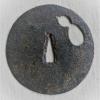Haidar,
TAMAHAGANE is produced in a range of different qualities. This is not intentional, but happens accidentally in the TATARA process. The basic material has low carbon content (around 0.3%), while some of the material is coming out of the TATARA as cast iron with more than 2% of carbon. The low-carbon TAMAHAGANE is mostly used for making SHINGANE, while cast iron is processed in OROSHIGANE furnaces to increase the carbon content of iron/steel. Other qualities are selected and sold on the basis of purity and hardness, but without material analysis.
As Jacques stated, carbon content in the cutting edges of Japanese swords changed over time. One approach to find the optimum steel may be the fact that carbon content in steel has a peak at 0.78%. At that point, carbon is fully solved in the steel matrix without forming carbides. This leads to a very fine structure and very high hardness which can go up to HRC 67. A higher carbon content does not result in higher hardness.
Before the upcoming scientific research in the industrial era, there was no knowledge about chemistry and metallurgy, but there was experience. Steel can be "felt" when working with it, and making small samples, hardening and tempering them, and watch how they 'behave' in bending or breaking tests tells a swordsmith all that is necessary to know.



